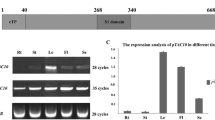Abstract
Light induces chloroplast (Cp) differentiation in dark-grown y-1 strains of Chlamydomonas reinhardtii. Slot blot analysis was used to quantitate tufA, psbA, psbK, rbcL, and 16S rRNA transcript accumulation and transcription during Cp differentiation. When etiolated cc-125 y-1 cells were illuminated for 5 h, a 1710 bp tufA mRNA accumulated up to 5-fold while the psbA, rbcL, and 16S rRNA transcripts accumulated less than 1.5-fold. The tufA gene encodes translational elongation factor EF-Tu. The light-induced accumulation of tufA mRNA did not occur in cc-1931, a strain that does not become etiolated in darkness. Pulse labelling was used to measure the transcription of Cp transcripts during tufA mRNA accumulation, and no detectable change in tufA transcription was observed. These results imply that the half life of the tufA transcript increases during the greening process.
Similar content being viewed by others
References
Ausubel FM, Brent R, Kingston RE, Moore DD, Seidman JG, Smith JA, Strahl K (eds): Current Protocols in Molecular Biology, pp. 4.5.1–4.8.3. John Wiley, New York (1989).
Baldauf SL, Palmer JD: Evolutionary transfer of the chloroplast tufA to the nucleus. Nature 344: 262–265 (1990).
Blowers AD, Ellmore GS, Klein U, Bogorad L: Transcriptional analysis of endogenous and foreign genes in chloroplast transformants of Chlamydomonas. Plant Cell 2: 1059–1070 (1990).
Breidenbach E, Leu S, Michaels A, Boschetti A, Synthesis of EF-Tu and distribution of its mRNA between stroma and thylakoids during the cell cycle of Chlamydomonasreinhardtii. Biochimica et Biophysica Acta 1048: 209–216 (1990).
Drapier D, Girard-Bascou J, Wollman F-A: Evidence fornuclear control of the expression of the atpA and atpB chloropolast genes in Chlamydomonas. The Plant Cell 4: 283–295 (1992).
Dron M, Rahire M, Rochaix JD: Sequence of the chloroplast 16S rRNA and its surrounding regions of Chlamydomonas reinhardtii. Nucleic Acids Res 10: 7609–7620 (1982).
Ford C, Wang W: Instability at the y-1 locus of Chlamydomonas reinhardtii. Mol Gen Genet 187: 286–290 (1982).
Gamble PE, Sexton TB, Mullet JE: Light-dependent changes in psbD and psbC transcripts of barley chloroplasts: Accumulation of two transcripts maintains psbD and psbC translation capability in mature chloroplasts. EMBO J 7: 1289–1297 (1988).
Gruissem W: Chloroplast gene expression: how plants turn their plastids on. Cell 56: 161–170 (1989).
Gruissem W, Barkan A, Deng X-W, Stern D, Transcriptional and posttranscriptional control of plastid mRNA levels in higher plants. Trends Genet 4: 258–263 (1988).
Haley J, Bogorad L: Alternative promoters are used for genes within maize chloroplast polycistronic transcription units. Plant Cell 2: 323–333 (1990).
Harris EH: The Chlamydomonas Sourcebook: A Comprehensive Guide to Biology and Laboratory Use. Academic Press. San Diego, CA (1989).
Hoober JK: Chloroplasts, pp. 200–221, Plenum Press, New York (1984).
Hoober JK, Siekevitz P, Palade GE: Formation of chloroplast membranes in Chlamydomonas reinhardtii y-1. J Biol Chem 244: 2621–2631 (1969).
Hoober JK, Stegeman WJ: Control of the synthesis of a major polypeptide of chloroplast membranes in Chlamydomonas reinhardtii. J Cell Biol 56: 1–12 (1973).
Klein RR, Mason HS, Mullet JE: Light-regulated translation of chloroplast proteins. I. Transcripts of PsaA-PsaB, PsbA, and RbcL are associated with polysomes in dark-grown and illuminated barley seedlings. J Cell Biol 106: 289–301 (1988).
Klein RR, Mullet JE: Light-induced transcription of Cp genes: psbA transcription is differentially enhanced in illuminated barley. J Biol Chem 265: 1895–1902 (1990).
Link G: DNA sequence requirements for the accurate transcription of a protein-coding plastid gene in a plastid in vitro system from mustard (Sinapsisalba L.) EMBO J 3: 1697–1704 (1984).
Malnoe P, Mayfield SP, Rochaix J-D: Comparative analysis of the biogenesis of photosystem II in the wild-type and y-1 mutant of Chlamydomonas reinhardtii. J Cell Biol 106: 609–616 (1988).
Matsuda Y, Surzyki SJ: Chloroplast gene expression in Chlamydomonas reinhardtii. Mol Gen Genet 180: 463–474 (1980).
Mullet JE, Klein RR: Transcription and RNA stability are important determinents of higher plant chloroplast RNA levels. EMBO J 6: 1571–1579 (1987).
Ohad I, Siekevitz P, Palade GE: Biogenesis of chloroplast membranes: plastid differentiation in a dark-grown algal mutant (Chlamydomonas reinhardtii). J Cell Biol 35: 521–552 (1967).
O'Neill MC: Concensus methods for finding and ranking DNA binding sites: applications to Escherichia coli promoters. J Mol Biol 207: 301–310 (1989).
Rochaix JD, Kuchka M, Mayfield S, Schirmer-Rahire M, Girard-Bascou J, Bennoun P: Nuclear and chloroplast mutations affect the synthesis or stability of the chloroplast psbC gene product in Chlamydomonas reinhardtii. EMBO J 8: 1013–1021 (1989).
Salvador ML, Klein U, Bogorad L: Light-regulated and endogenous fluctuations of chloroplast transcript levels in Chlamydomonas. Regulation by transcription and RNA degradation. Plant J (in press).
Silk GW, Dela Cruz F, Wu M: Nucleotide sequence of the chloroplast gene for the 4 kD K polypeptide of photosystem II (psbK) and the psbK-tufA intergenic region of Chlamydomonas reinhardtii. Nucl Acids Res 18: 4930 (1990).
Silk GW, Wu M: Darkness and antibiotics increase the steady-state transcripts of the elongation factor gene (tuf) in Chlamydomonas reinhardtii. Curr Genet 14: 119–126 (1988).
Silk GW, Wu M: 3′ Transcript mapping of the Chlamydomonas reinhardtii chloroplast psbK mRNA using a novel method to prepare 3′ end-labelled single-stranded DNA probes. Biotechniques 14: 830–833 (1993).
Stern DB, Radwanski ER, Kindle KL: A 3′ stem/loop structure of the Chlamydomonas chloroplast atpB gene regulates mRNA accumulation in vivo. Plant Cell 3: 285–297 (1991).
Sugiura M: The chloroplast chromosomes in land plants. Annu Rev Cell Biol 5: 51–70 (1989).
Yao WB, Meng BY, Tanaka M, Sugiura M: An additional promoter within the protein-coding region of the psbD-psbC gene cluster in tobacco chloroplast DNA. Nucl Acids Res 23: 9583–9591 (1989).
Zuker M, Steigler P: Optimal computer folding of large RNA sequences using thermodynamics and auxilliary information. Nucl Acids Res 9: 133–148 (1981).
Author information
Authors and Affiliations
Rights and permissions
About this article
Cite this article
Silk, G.W., Wu, M. Posttranscriptional accumulation of chloroplast tufA (elongation factor gene) mRNA during chloroplast development in Chlamydomonas reinhardtii . Plant Mol Biol 23, 87–96 (1993). https://doi.org/10.1007/BF00021422
Received:
Accepted:
Issue Date:
DOI: https://doi.org/10.1007/BF00021422




